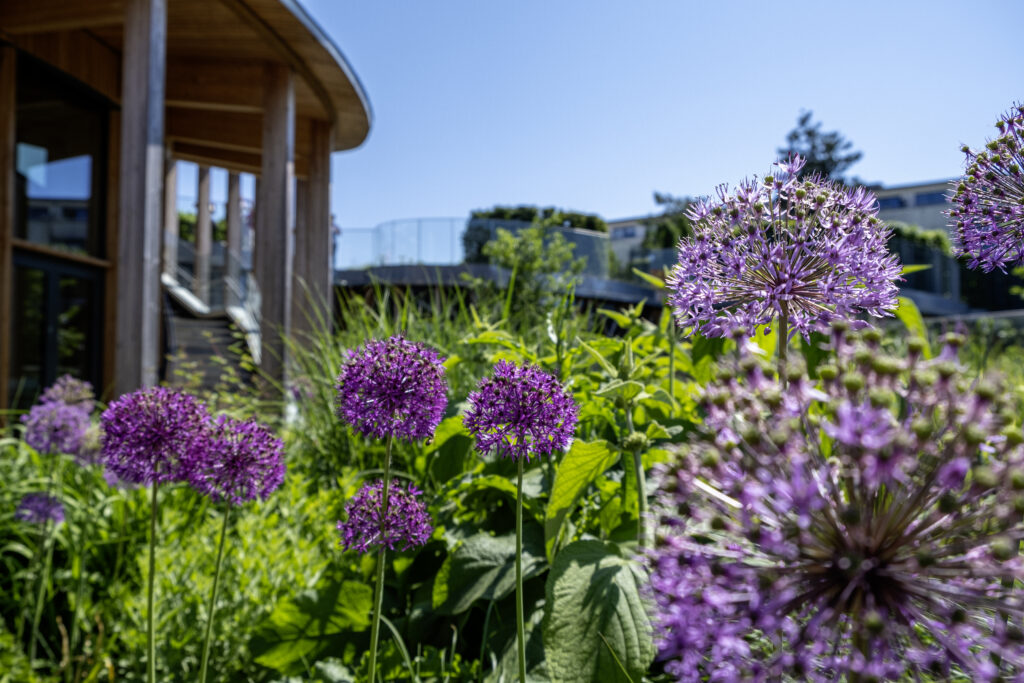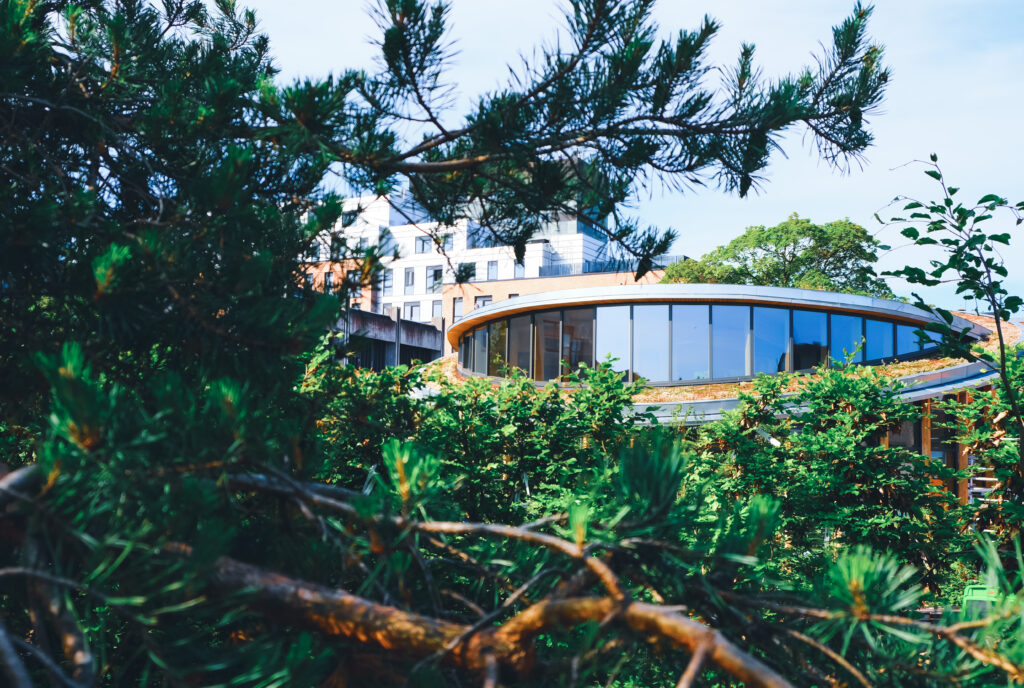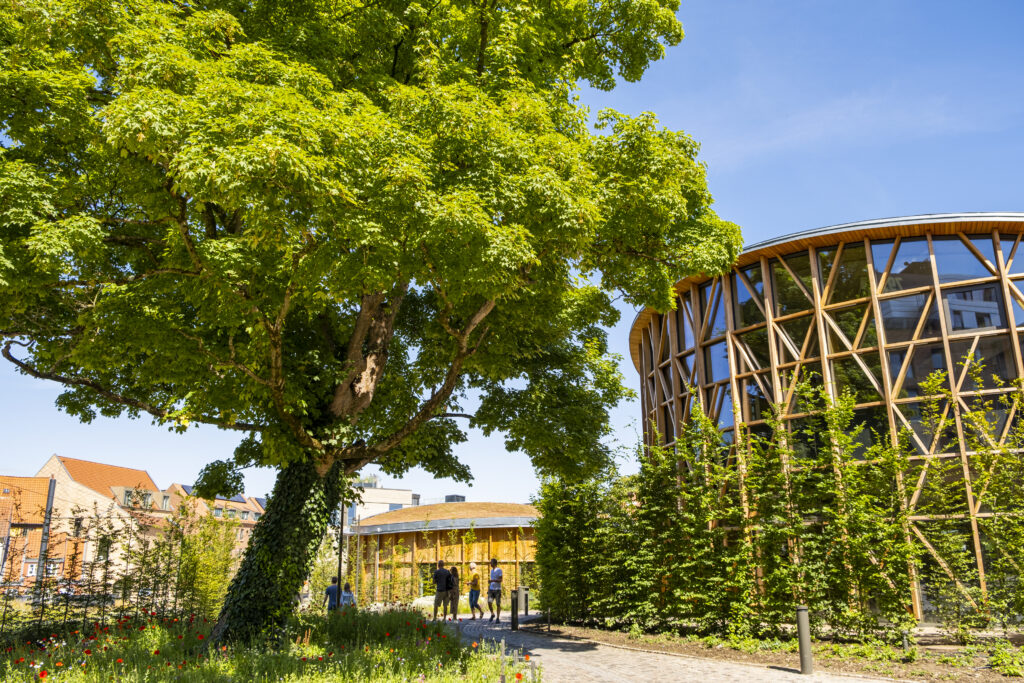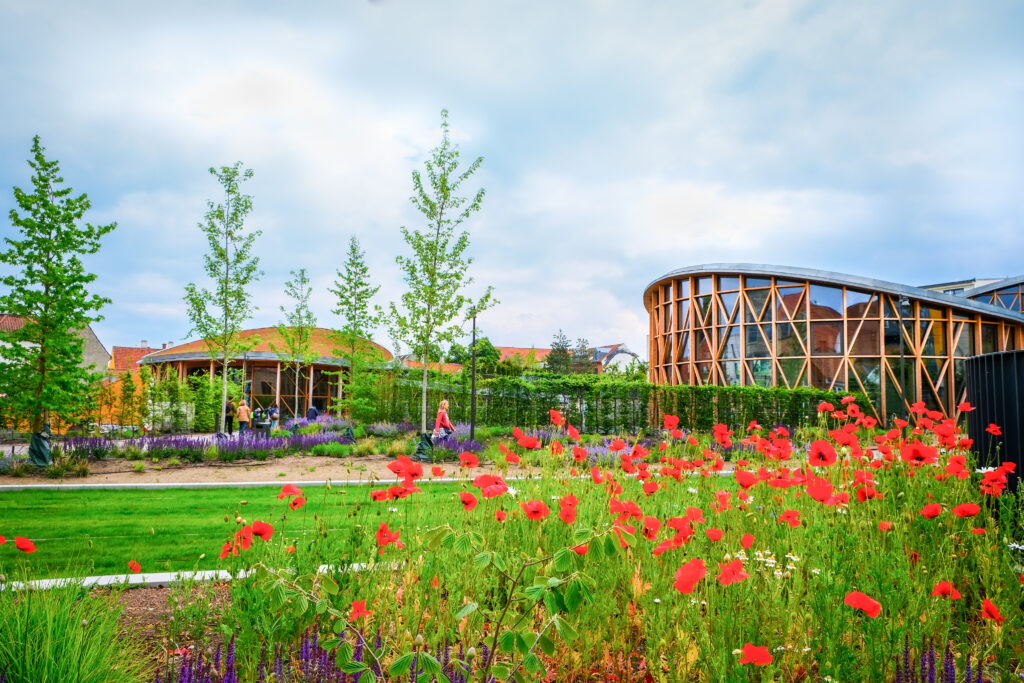H.C. Andersen Gardens
A tribute to the imagination, to the inquisitiveness, and to the wondrous moments of everyday life. The H.C. Andersen Gardens draw inspiration from the themes and moods of Hans Christian Andersen’s fairy tales.
The Gardens are designed by the landscape architects MASU Planning in dialogue with the architects Kengo Kuma & Associates.

The Welcome Garden
With its mix of perennials, bulbs, and ornamental grasses, the beautiful flower bed in the Welcome Garden is a colourful hint at the experiences awaiting visitors inside the museum and outside in the gardens.
Travelling, sensing, and experiencing the world in new ways are basic themes in Hans Christian Andersen’s fairy tales and also fundamental to the gardens. Visitors will not encounter specific fairy tales or characters; instead, they can venture into a world where shapes, colours, and fragrances titillate their senses and imagination, challenging the boundary between everyday life and the fairy tale world.
Andersen’s universe is ambiguous and complex; there is no one truth, as such, and the stories often lack a single central element. In the same way, the gardens are a labyrinthine universe without a specific centre: meandering pathways invite visitors and passers-by into the gardens and guide them around the various spaces; sometimes up and sometimes down – the perspectives change, and we never quite know what awaits us round the next corner. A world just begging to be explored. Like a Hans Christian Andersen fairy tale yet unknown.
The Sunken Gardens
The way Hans Christian Andersen makes inspired use of perspective in his fairy tales is reflected in the split-level garden design. The museum covers an area of 5600 square metres, of which two thirds are below ground. Two sunken gardens add depth to the museum layout, bringing together the building, exhibition, and gardens. What is up and what is down? What is outside and what is inside? Our senses are roused when standing at ground level looking into treetops emerging from the level below, or when we are far below ground level and look out into lush greenery.
The larger sunken garden is a nod from the landscape architects to the Danish wooded landscape with a small lake and the ancient tree species of alder and oak. The plants are carefully selected to create an illusion of a forest floor where bracken, hazelwort, and woodruff extend like a soft and luxuriant carpet. Small footbridges frame the greenery, creating a beautiful tableau for visitors to immerse themselves in.
In the smaller sunken garden, a forest floor and alder trees welcome visitors when they emerge from the underground car park whilst, at the same time, sending a whiff of greenery to the passing motorists underground.


The Giants’ Garden
Hans Christian Andersen’s fairy tales often add a fresh angle to our familiar view of the world because of the surprising perspectives used to present it to us: from the viewpoint of a tin soldier, an oak tree, or even the wind. His ability to broaden our perspective allows us to experience the world around us with a degree of wonder.
In The Giants’ Garden, visitors are surrounded by huge, almost over-dimensioned plants. With their giant leaves, plants like giant rhubarb, empress tree, and rice-paper plant suddenly make one feel small like Thumbelina, entirely humble in a world of giants. Visitors following the garden path will experience how it suddenly narrows, making them feel bigger – filling out the space – it is easy momentarily to lose one’s sense of direction to be enveloped in foliage, fragrances, and colours. In this way, the garden space modifies our perception of size and scale, and visitors will alternately feel large and small.
NB during wintertime, some of the plants mentioned here are cut back and have taken winter cover, while others will have a warm winter coat of straw, so that the exotic plants will survive the cold Danish winter while waiting for the warm sun and brighter days.
The Mirror Pool
The Mirror Pool is calm like an unpainted canvas and mirrors the surrounding hedges and the sky. But there is more to this than just being a pool: it is directly linked to the museum’s subterranean fairy tale world. In the fairy tale installation ’The Little Mermaid’, museum visitors find themselves below sea level glimpsing wild mermaids and, from time to time, a sinking shipwrecked sailor. Visitors can also look up through the pool’s surface to the sky, watch birds winging past, drifting clouds, or perhaps falling rain in the world above water. Just like the little mermaid in the fairy tale.
The changing seasons constantly alter the colour and expression of the hedges, giving the garden a dynamic and animate character all year round. In the summer, the garden is a labyrinth of greenery. In the winter, the branch structure of the hedges sheltering the part of it facing the city, all of them hornbeam, is light and transparent, allowing passers-by a glimpse of the garden. At the centre, beech and yew hedges create denser and more compacted garden spaces.


The Dark Garden
When visitors walk along the meandering path, they are not merely walking in a garden but on the roof of the museum. The journey outside is not unlike the one the visitors inside the museum undertake. Here, too, are meandering and tortuous corridors leading to fabulous variously-themed rooms: light and dark meet, humour takes the place of seriousness precisely as in Hans Christian Andersen’s fairy tales.
Andersen’s universe is not just bright and playful. Many of his fairy tales embrace the darkness and loneliness that he knew in his own life – and he also wrote poignantly about people’s mindless behaviour towards one another and nature. This is the darkness that welcomes visitors in The Dark Garden. The bright foliage of the beech hedges has gone, replaced by dark yew, and the dense fir trees keep out the light while climbers including dark honeysuckle and creeping gnarly dwarf beech help create a condensed atmosphere. Perhaps they remind visitors of the trolls and subterranean creatures known to Hans Christian Andersen from ancient folk tales and incorporated into his fairy tales? And just look at the bowed-down Finnish firs – why do they hang their heads in this way?
The Bright Garden
The highest spot in the H.C. Andersen Gardens is The Bright Garden. Flowers and foliage are carefully selected to create a playful and bubbly atmosphere, and colour and fragrances change through the flowering season: from the lilac and white nuances of spring to the colourful explosion of summer perennials, including blue feverweed and yellow helenium.
Plants are wholly essential in the H.C. Andersen Gardens. The plant combination is the result of careful selection to clearly reflect the expression of changing seasons, and every flowerbed follows an ongoing flowering plan all year round. All flower beds are carefully harmonised. The texture, fragrance, shapes, and colours of the plants create special moods. Moreover, the variety of flowers, grasses, and trees forms a habitat for many different birds, insects, and butterflies gracing the garden in summer.
From The Bright Garden, it becomes evident how the hedges are trimmed to fit in with the scale of the city and the people in the garden: tall hedges facing the modern part of the city with its tall high-rises, and low hedges at the centre and the part facing the old district with its small listed half-timbered houses.


The Light Tree
A decision was made to save this old maple tree when constructing the new museum. The tree is known as the Light Tree, since the people of Odense used to deck it with fairy lights. Today, the fairy lights have gone, and the tree is allowed to grow unhindered. Quite in the spirit of the fairy tale writer, the tree stands as a witness to the construction of the new museum; a link between past and present. A story worthy of a Hans Christian Andersen fairy tale.
The architects respected the tree when designing the building containing the children’s universe Ville Vau. The centre of the building features a ‘tree trunk’, branching off at the very top into a beautiful wooden ceiling construction in the museum studio. Similarly, the top of The Light Tree plays an important role for the light coming into the studio, since its branches filter the light, changing it with the foliage and season. In this way, the tree continues to live up to its popular name.
The maple is the largest tree in the H.C. Andersen Gardens but not the only one: thirty-seven trees were planted, including silver maple, ginkgo, and dwarf mountain pine. All hedge plants and trees were bought as mature trees to achieve the desired height and effect without undue delay.
The West Garden
Before the new H.C. Andersen’s House and H.C. Andersen Gardens were opened (2021), the four-lane Thomas B. Thriges Gade cut through the city. In a new city project begun in 2014, the street was closed and the H.C. Andersen Gardens became central to re-establishing this city area. The gardens were to be a lush oasis and organic link between the new and old city districts.
The West Garden is located on the periphery if the H.C. Andersen Gardens. It serves to draw the green space out into the city while also creating a portal into the new gardens by the museum. Some of the varieties of meadow grasses, hedges, perennials, and trees found in the remaining part of the H.C. Andersen Gardens are also found here. Further, this is the spot where the light-railway and super cycle path infrastructure have been integrated into the area.
In The West Garden, visitors move from busy everyday life into the museum’s playful and narrative universe inspired by Hans Christian Andersen’s unique way of looking at and writing about the world. Their senses are awakened, tempting them to explore the additional green spaces in the H.C. Andersen Gardens. Moreover, The West Garden is a green nod to visitors as they walk away from the fabulous gardens towards the city centre.

The presentation of the H.C. Andersen Garden is made possible with support from the Danish Board of Business Development.

